What Phase Are Chromosomes Replicated
Chapter half dozen: Introduction to Reproduction at the Cellular Level
6.2 The Cell Cycle
Learning Objectives
By the finish of this section, you lot will be able to:
- Describe the three stages of interphase
- Discuss the behavior of chromosomes during mitosis and how the cytoplasmic content divides during cytokinesis
- Define the quiescent G0 phase
- Explain how the three internal control checkpoints occur at the end of G1, at the Gtwo–One thousand transition, and during metaphase
The cell bicycle is an ordered series of events involving prison cell growth and cell division that produces ii new daughter cells. Cells on the path to prison cell sectionalisation proceed through a series of precisely timed and carefully regulated stages of growth, DNA replication, and division that produce two genetically identical cells. The prison cell cycle has two major phases: interphase and the mitotic stage (Figure 6.3). During interphase, the cell grows and Deoxyribonucleic acid is replicated. During the mitotic phase, the replicated DNA and cytoplasmic contents are separated and the cell divides.
Watch this video nearly the cell cycle: https://www.youtube.com/lookout man?5=Wy3N5NCZBHQ
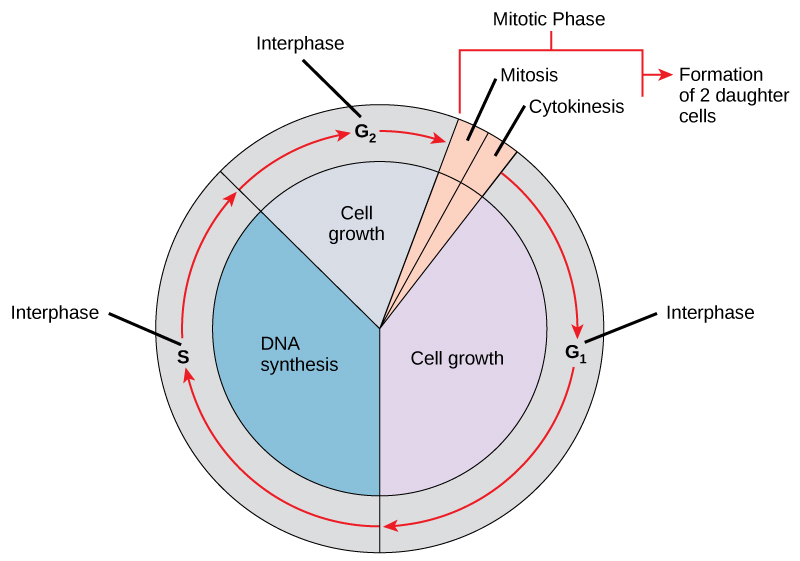
Interphase
During interphase, the jail cell undergoes normal processes while as well preparing for cell segmentation. For a cell to move from interphase to the mitotic phase, many internal and external weather must exist met. The 3 stages of interphase are called Gi, S, and G2.
Gane Phase
The first phase of interphase is called the G1 phase, or first gap, because little change is visible. However, during the Chiliad1 stage, the cell is quite agile at the biochemical level. The cell is accumulating the building blocks of chromosomal Deoxyribonucleic acid and the associated proteins, as well as accumulating enough energy reserves to complete the task of replicating each chromosome in the nucleus.
S Phase
Throughout interphase, nuclear DNA remains in a semi-condensed chromatin configuration. In the Due south phase (synthesis phase), DNA replication results in the formation of ii identical copies of each chromosome—sister chromatids—that are firmly fastened at the centromere region. At this phase, each chromosome is made of 2 sister chromatids and is a duplicated chromosome. The centrosome is duplicated during the Southward stage. The two centrosomes will give rise to the mitotic spindle, the apparatus that orchestrates the motility of chromosomes during mitosis. The centrosome consists of a pair of rod-like centrioles at correct angles to each other. Centrioles assistance organize cell segmentation. Centrioles are non present in the centrosomes of many eukaryotic species, such as plants and most fungi.
G2 Phase
In the Gtwo phase, or 2nd gap, the jail cell replenishes its free energy stores and synthesizes the proteins necessary for chromosome manipulation. Some cell organelles are duplicated, and the cytoskeleton is dismantled to provide resources for the mitotic spindle. At that place may be additional cell growth during Grand2. The final preparations for the mitotic phase must exist completed earlier the cell is able to enter the outset stage of mitosis.
The Mitotic Stage
To brand two daughter cells, the contents of the nucleus and the cytoplasm must be divided. The mitotic phase is a multistep process during which the duplicated chromosomes are aligned, separated, and moved to opposite poles of the cell, and then the prison cell is divided into two new identical daughter cells. The showtime portion of the mitotic phase, mitosis, is equanimous of v stages, which achieve nuclear partition. The second portion of the mitotic phase, called cytokinesis, is the physical separation of the cytoplasmic components into two daughter cells.
Mitosis
Mitosis is divided into a series of phases—prophase, prometaphase, metaphase, anaphase, and telophase—that upshot in the division of the cell nucleus (Effigy 6.iv).
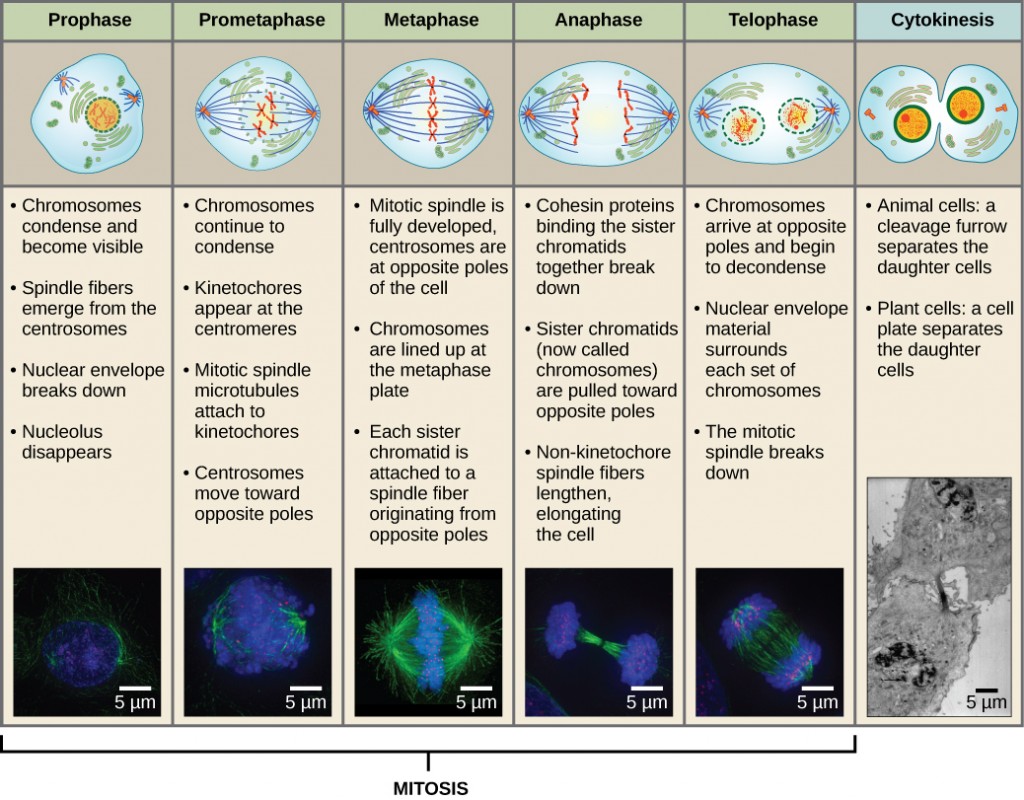
Which of the following is the correct order of events in mitosis?
- Sister chromatids line up at the metaphase plate. The kinetochore becomes attached to the mitotic spindle. The nucleus re-forms and the cell divides. The sister chromatids separate.
- The kinetochore becomes fastened to the mitotic spindle. The sister chromatids split up. Sister chromatids line upward at the metaphase plate. The nucleus re-forms and the cell divides.
- The kinetochore becomes fastened to metaphase plate. Sis chromatids line up at the metaphase plate. The kinetochore breaks down and the sister chromatids separate. The nucleus re-forms and the cell divides.
- The kinetochore becomes attached to the mitotic spindle. Sis chromatids line upwards at the metaphase plate. The kinetochore breaks autonomously and the sister chromatids separate. The nucleus re-forms and the cell divides.
During prophase, the "outset phase," several events must occur to provide access to the chromosomes in the nucleus. The nuclear envelope starts to suspension into small vesicles, and the Golgi apparatus and endoplasmic reticulum fragment and disperse to the periphery of the prison cell. The nucleolus disappears. The centrosomes begin to motion to contrary poles of the cell. The microtubules that form the basis of the mitotic spindle extend between the centrosomes, pushing them farther autonomously equally the microtubule fibers lengthen. The sister chromatids begin to whorl more tightly and become visible under a low-cal microscope.
During prometaphase, many processes that were begun in prophase continue to advance and culminate in the formation of a connection between the chromosomes and cytoskeleton. The remnants of the nuclear envelope disappear. The mitotic spindle continues to develop every bit more microtubules assemble and stretch across the length of the erstwhile nuclear surface area. Chromosomes go more condensed and visually detached. Each sis chromatid attaches to spindle microtubules at the centromere via a poly peptide complex called the kinetochore.
During metaphase, all of the chromosomes are aligned in a airplane called the metaphase plate, or the equatorial plane, midway between the two poles of the cell. The sis chromatids are yet tightly attached to each other. At this time, the chromosomes are maximally condensed.
During anaphase, the sister chromatids at the equatorial plane are dissever apart at the centromere. Each chromatid, at present chosen a chromosome, is pulled rapidly toward the centrosome to which its microtubule was attached. The cell becomes visibly elongated as the non-kinetochore microtubules slide against each other at the metaphase plate where they overlap.
During telophase, all of the events that prepare up the duplicated chromosomes for mitosis during the beginning three phases are reversed. The chromosomes reach the opposite poles and begin to decondense (unravel). The mitotic spindles are broken down into monomers that will be used to assemble cytoskeleton components for each daughter cell. Nuclear envelopes form around chromosomes.
Concept in Action

This page of movies illustrates dissimilar aspects of mitosis. Scout the motion picture entitled "DIC microscopy of jail cell segmentation in a newt lung cell" and place the phases of mitosis.
Cytokinesis
Cytokinesis is the second part of the mitotic stage during which cell division is completed past the physical separation of the cytoplasmic components into two daughter cells. Although the stages of mitosis are like for almost eukaryotes, the procedure of cytokinesis is quite different for eukaryotes that take cell walls, such as plant cells.
In cells such as fauna cells that lack cell walls, cytokinesis begins following the onset of anaphase. A contractile ring equanimous of actin filaments forms just within the plasma membrane at the sometime metaphase plate. The actin filaments pull the equator of the cell inward, forming a fissure. This cleft, or "crack," is called the cleavage furrow. The furrow deepens every bit the actin ring contracts, and somewhen the membrane and cell are cleaved in 2 (Figure half-dozen.v).
In plant cells, a cleavage furrow is non possible because of the rigid cell walls surrounding the plasma membrane. A new jail cell wall must grade between the daughter cells. During interphase, the Golgi appliance accumulates enzymes, structural proteins, and glucose molecules prior to breaking upward into vesicles and dispersing throughout the dividing cell. During telophase, these Golgi vesicles move on microtubules to collect at the metaphase plate. There, the vesicles fuse from the center toward the cell walls; this structure is called a jail cell plate. As more than vesicles fuse, the jail cell plate enlarges until it merges with the cell wall at the periphery of the jail cell. Enzymes utilize the glucose that has accumulated between the membrane layers to build a new cell wall of cellulose. The Golgi membranes go the plasma membrane on either side of the new jail cell wall (Figure 6.v).
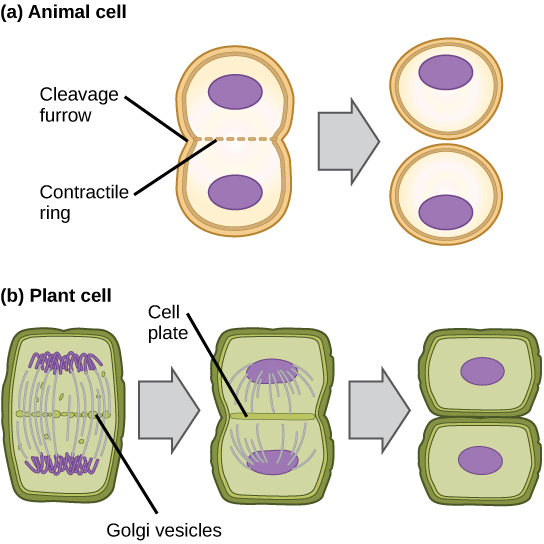
G0 Phase
Not all cells adhere to the archetype cell-cycle pattern in which a newly formed daughter cell immediately enters interphase, closely followed by the mitotic stage. Cells in the G0 phase are not actively preparing to split up. The jail cell is in a quiescent (inactive) phase, having exited the cell cycle. Some cells enter G0 temporarily until an external signal triggers the onset of Mone. Other cells that never or rarely divide, such as mature cardiac muscle and nerve cells, remain in G0 permanently (Effigy 6.6).
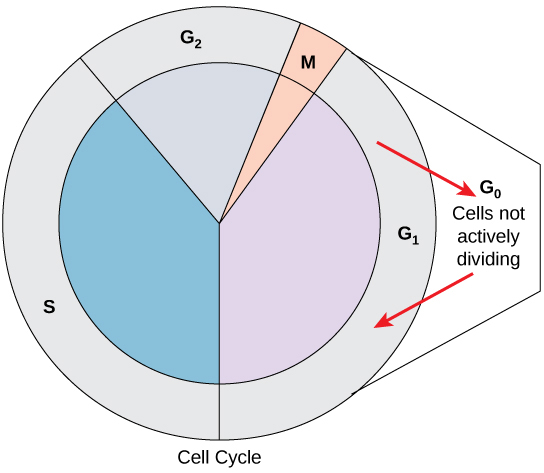
Control of the Prison cell Cycle
The length of the prison cell cycle is highly variable even within the cells of an individual organism. In humans, the frequency of cell turnover ranges from a few hours in early embryonic development to an average of two to five days for epithelial cells, or to an entire human lifetime spent in One thousand0 by specialized cells such as cortical neurons or cardiac muscle cells. There is also variation in the time that a cell spends in each phase of the prison cell cycle. When fast-dividing mammalian cells are grown in culture (outside the body nether optimal growing atmospheric condition), the length of the cycle is approximately 24 hours. In rapidly dividing human being cells with a 24-hr cell cycle, the Grandi phase lasts approximately eleven hours. The timing of events in the cell cycle is controlled by mechanisms that are both internal and external to the cell.
Regulation at Internal Checkpoints
It is essential that girl cells be verbal duplicates of the parent prison cell. Mistakes in the duplication or distribution of the chromosomes atomic number 82 to mutations that may be passed forrad to every new cell produced from the abnormal cell. To foreclose a compromised cell from standing to divide, there are internal control mechanisms that operate at three chief prison cell cycle checkpoints at which the prison cell cycle can be stopped until conditions are favorable. These checkpoints occur near the end of Grand1, at the Gtwo–M transition, and during metaphase (Figure 6.7).
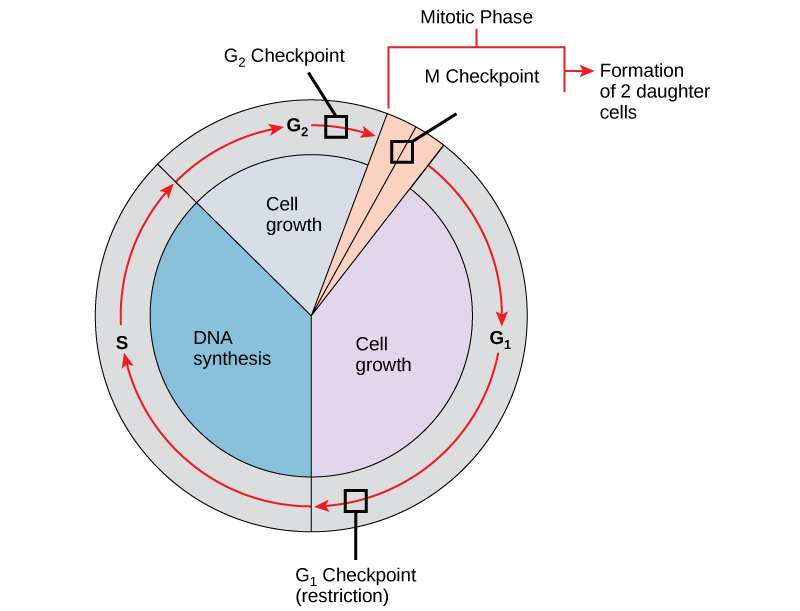
The G1 Checkpoint
The One thousandane checkpoint determines whether all atmospheric condition are favorable for jail cell division to proceed. The G1 checkpoint, also called the restriction point, is the point at which the cell irreversibly commits to the cell-segmentation process. In addition to adequate reserves and cell size, there is a check for damage to the genomic DNA at the 1000ane checkpoint. A cell that does not run into all the requirements volition non be released into the S stage.
The Yard2 Checkpoint
The G2 checkpoint bars the entry to the mitotic phase if certain conditions are not met. Every bit in the G1 checkpoint, cell size and protein reserves are assessed. Yet, the most important role of the Thousandtwo checkpoint is to ensure that all of the chromosomes have been replicated and that the replicated DNA is not damaged.
The G Checkpoint
The Chiliad checkpoint occurs near the end of the metaphase stage of mitosis. The Grand checkpoint is as well known equally the spindle checkpoint considering it determines if all the sister chromatids are correctly attached to the spindle microtubules. Because the separation of the sis chromatids during anaphase is an irreversible step, the bike will non proceed until the kinetochores of each pair of sis chromatids are firmly anchored to spindle fibers arising from opposite poles of the prison cell.
Concept in Activity

Watch what occurs at the Ki, G2, and M checkpoints by visiting this animation of the jail cell bicycle.
Department Summary
The prison cell wheel is an orderly sequence of events. Cells on the path to cell division proceed through a series of precisely timed and carefully regulated stages. In eukaryotes, the cell cycle consists of a long preparatory menses, called interphase. Interphase is divided into Gone, S, and G2 phases. Mitosis consists of five stages: prophase, prometaphase, metaphase, anaphase, and telophase. Mitosis is normally accompanied by cytokinesis, during which the cytoplasmic components of the girl cells are separated either by an actin ring (animal cells) or by jail cell plate formation (plant cells).
Each pace of the cell cycle is monitored past internal controls called checkpoints. There are three major checkpoints in the prison cell cycle: one near the end of Thou1, a second at the One thousand2–M transition, and the tertiary during metaphase.
Glossary
anaphase : the phase of mitosis during which sister chromatids are separated from each other
cell bike : the ordered sequence of events that a cell passes through betwixt one cell division and the side by side
cell cycle checkpoints: mechanisms that monitor the preparedness of a eukaryotic cell to advance through the diverse cell cycle stages
prison cell plate: a construction formed during plant-cell cytokinesis by Golgi vesicles fusing at the metaphase plate; volition ultimately lead to formation of a prison cell wall to dissever the two daughter cells
centriole: a paired rod-similar structure synthetic of microtubules at the eye of each animal cell centrosome
cleavage furrow: a constriction formed by the actin ring during animal-jail cell cytokinesis that leads to cytoplasmic division
cytokinesis: the segmentation of the cytoplasm post-obit mitosis to form two daughter cells
Grand0 stage: a jail cell-cycle phase distinct from the Gone phase of interphase; a cell in G0 is not preparing to carve up
G1 stage : (also, first gap) a jail cell-bicycle phase; starting time stage of interphase centered on cell growth during mitosis
G2 phase: (also, second gap) a cell-cycle stage; third phase of interphase where the jail cell undergoes the terminal preparations for mitosis
interphase: the catamenia of the cell bike leading upwardly to mitosis; includes G1, S, and Thou2 phases; the interim between two consecutive cell divisions
kinetochore: a protein construction in the centromere of each sister chromatid that attracts and binds spindle microtubules during prometaphase
metaphase plate: the equatorial aeroplane midway between two poles of a jail cell where the chromosomes align during metaphase
metaphase : the phase of mitosis during which chromosomes are lined up at the metaphase plate
mitosis: the menses of the cell cycle at which the duplicated chromosomes are separated into identical nuclei; includes prophase, prometaphase, metaphase, anaphase, and telophase
mitotic phase: the period of the cell cycle when duplicated chromosomes are distributed into two nuclei and the cytoplasmic contents are divided; includes mitosis and cytokinesis
mitotic spindle: the microtubule apparatus that orchestrates the motion of chromosomes during mitosis
prometaphase : the stage of mitosis during which mitotic spindle fibers attach to kinetochores
prophase: the stage of mitosis during which chromosomes condense and the mitotic spindle begins to form
quiescent: describes a jail cell that is performing normal cell functions and has non initiated preparations for cell division
S phase: the second, or synthesis phase, of interphase during which Deoxyribonucleic acid replication occurs
telophase: the stage of mitosis during which chromosomes arrive at contrary poles, decondense, and are surrounded by new nuclear envelopes
What Phase Are Chromosomes Replicated,
Source: https://opentextbc.ca/biology/chapter/6-2-the-cell-cycle/
Posted by: williamsstenly.blogspot.com


0 Response to "What Phase Are Chromosomes Replicated"
Post a Comment